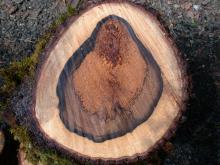See:
Oak (Quercus spp.) - Inonotus Root and Butt Rot
Cause Inonotus dryophilus (formerly Polyporus dryophilus), a common trunk and branch decay fungus on oaks, especially on Oregon white oak and California black oak. Presence of conks indicates decay, but the extent of decay is difficult to determine from external indicators alone. Decay in the trunk or large branches increases the failure potential of the tree.
Wood decay fungi enter trees primarily through wounds that expose sapwood or heartwood. Injuries from pruning, sunburn, lightning, or cultivating equipment can expose susceptible wood. Large wounds and stub and horizontal cuts are often entry sites for decay fungi. Mycelial growth of the fungus proceeds with colonization and utilization of wood as a food source. Live trees are able to limit wood decay by walling off and compartmentalizing decay fungi but this can vary between different species and individuals. The CODIT model/principle (compartmentalization of decay in trees) is used by certified arborists to manage landscape trees with decay.
Symptoms Sparse foliage with limb dieback may be symptomatic but these are not consistently associated with the disease. Decay is a white pocket rot of the heartwood of living trees, usually in the upper bole and large branches (unlike Inonotus root and butt rot, which always occurs near ground level). Annual conks appear on upper bole usually near knots, broken branches or pruning wounds. Conks are large (3.5 to 12 inches in diameter), thick, usually shelf-shaped, light brown initially, then dark brown. The decay consists of long white pockets (pipes) separated by darker and more solid wood. Conks deteriorate during winter to a very dark-brown color and usually fall from tree within a year of formation.
Cultural control
- Irrigation water, especially from sprinklers, should not wet the trunks.
- Inspect trees for decay to assess tree stability.
- Remove affected trees to avoid damage to surrounding property.
Reference Boyce, J.S. 1961. Forest Pathology, third edition. McGraw-Hill Book Company.



